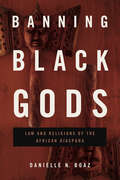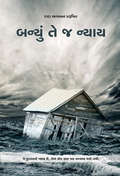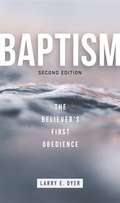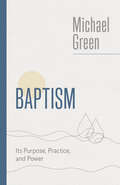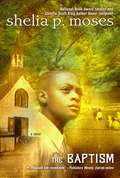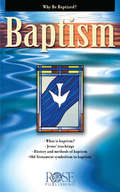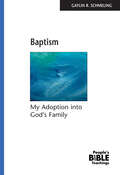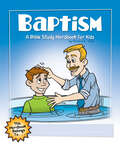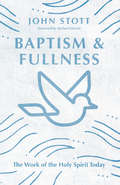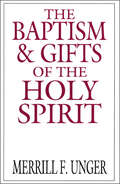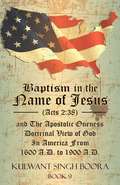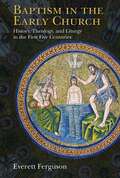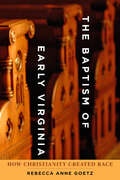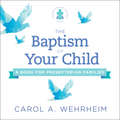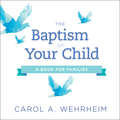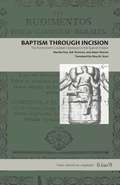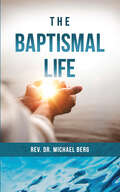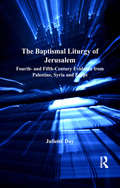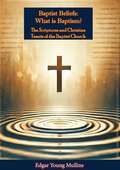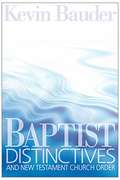- Table View
- List View
Banning Black Gods: Law and Religions of the African Disapora (Africana Religions #6)
by Danielle N. BoazBanning Black Gods is a global examination of the legal challenges faced by adherents of the most widely practiced African-derived religions in the twenty-first century, including Santeria/Lucumi, Haitian Vodou, Candomblé, Palo Mayombe, Umbanda, Islam, Rastafari, Obeah, and Voodoo. Examining court cases, laws, human rights reports, and related materials, Danielle N. Boaz argues that restrictions on African diaspora religious freedom constitute a unique and pervasive form of anti-Black discrimination.Emphasizing that these twenty-first-century cases and controversies are not a new phenomenon but rather a reemergence of colonial-era ideologies and patterns of racially motivated persecution, Boaz focuses each chapter on a particular challenge to Black religious freedom. She examines issues such as violence against devotees, restrictions on the ritual slaughter of animals, limitations on the custodial rights of parents, and judicial refusals to recognize these faiths as protected religions. Boaz introduces new issues that have never been considered as a question of religious freedom before—such as the right of Palo Mayombe devotees to possess remains of the dead—and she brings together controversies that have not been previously regarded as analogous, such as the right to wear headscarves and the right to wear dreadlocks in schools. Framing these issues in comparative perspective and focusing on transnational and transregional issues, Boaz advances our understanding of the larger human rights disputes that country-specific studies can overlook.Original and compelling, this important new book will be welcomed by students and scholars of African diaspora religions and discerning readers interested in learning more about the history of racial discrimination
Banning Black Gods: Law and Religions of the African Diaspora (Africana Religions)
by Danielle N. BoazBanning Black Gods is a global examination of the legal challenges faced by adherents of the most widely practiced African-derived religions in the twenty-first century, including Santeria/Lucumi, Haitian Vodou, Candomblé, Palo Mayombe, Umbanda, Islam, Rastafari, Obeah, and Voodoo. Examining court cases, laws, human rights reports, and related materials, Danielle N. Boaz argues that restrictions on African diaspora religious freedom constitute a unique and pervasive form of anti-Black discrimination.Emphasizing that these twenty-first-century cases and controversies are not a new phenomenon but rather a reemergence of colonial-era ideologies and patterns of racially motivated persecution, Boaz focuses each chapter on a particular challenge to Black religious freedom. She examines issues such as violence against devotees, restrictions on the ritual slaughter of animals, limitations on the custodial rights of parents, and judicial refusals to recognize these faiths as protected religions. Boaz introduces new issues that have never been considered as a question of religious freedom before—such as the right of Palo Mayombe devotees to possess remains of the dead—and she brings together controversies that have not been previously regarded as analogous, such as the right to wear headscarves and the right to wear dreadlocks in schools. Framing these issues in comparative perspective and focusing on transnational and transregional issues, Boaz advances our understanding of the larger human rights disputes that country-specific studies can overlook.Original and compelling, this important new book will be welcomed by students and scholars of African diaspora religions and discerning readers interested in learning more about the history of racial discrimination
Banyu Tej Nyay: બન્યું તે જ ન્યાય
by Dada Bhagwanજો તમે બન્યું તે ન્યાય કહેશો તો તમારા બધા પ્રશ્નો દૂર થઇ જશે. છતાંપણ, લોકો ન્યાય ખોળે છે અને મુક્તિની ઈચ્છા પણ રાખે છે. આ વિરોધાભાસ છે. તમને બન્નેના મળી શકે. જ્યાં સમસ્યાઓ પૂરી થાય છે ત્યાં મુક્તિની શરૂઆત થાય છે. આ આપણા અક્રમ વિજ્ઞાન ( ક્રમ વિનાનું આત્માનું જ્ઞાન ) તરીકે ઓળખાતા વિજ્ઞાનમાં કોઈ પ્રશ્નો રહેતા નથી. તેથી લોકો માટે આ માર્ગે ચાલવું સહેલું છે. પરમ પૂજ્ય દાદાશ્રીએ આ જગતને અસામાન્ય શોધ આપી છે કે આ જગત માં ક્યારેય પણ અન્યાય થતો જ નથી. જે બન્યું તે જ ન્યાય. કુદરત ક્યારેય ન્યાય થી વિરુદ્ધ ગઈ નથી. કુદરત એ કોઈ વ્યક્તિ કે ભગવાન નથી કે જે કોઈ પ્રભાવ હેઠળ હોય. કુદરત એટલે સાયન્ટીફીક સરકમસ્ટેનસીયલ એવીડન્સીસ. એક કાર્ય પૂરું થવા માટે ઘણા બધા સંજોગો ભેગા થવા જોઈએ.
Baptism: The Believer's First Obedience
by Larry E. DyerAnswers to the most important questions about Christian baptismBaptism is a step of obedience for every believer, but behind this simple act lies a rich tapestry of Christian belief and teaching. In the second edition of this short volume, Larry Dyer responds to the most common questions Christians have about baptism in nontechnical language, making it ideal for personal or small-group study. He explains what baptism is, what it means, why it is necessary, and what the mode of baptism should be. He also addresses whether infant baptism should be practiced, and whether baptism contributes to a believer's salvation. He ends the book with practical advice for how to prepare for and enjoy one's experience of baptism.
Baptism: Its Purpose, Practice, and Power (The Eerdmans Michael Green Collection)
by Michael GreenMichael Green offers biblical and ecumenical answers to disputed questions about baptism. The gateway into the church. An individual&’s testimony to faith and repentance. The reception of the Holy Spirit. The meaning of baptism varies wildly between different Christian traditions. Seeking common ground, Michael Green turns to Scripture to assess the varieties of baptismal theology. Though Green assents that baptism is no substitute for saving faith, he endorses infant baptism, confronting common objections head-on. He also addresses the related problems of confirmation and rebaptism. Green&’s lively and clear argument will challenge and intrigue readers of all denominations.
The Baptism
by Shelia P. MosesWhen you turn twelve in Occoneechee Neck in Jackson, North Carolina, everything changes. You get to do stuff you couldn't do when you were eleven. And it means it's time to get baptized. Twin brothers Leon and Luke Curry turned twelve last month. Ma has given them one week in which to do right -- to cleanse themselves of their sinning ways and get themselves ready for the baptism. Next Sunday they will go down to the "mornin' bench" at church, sit in front of Reverend Webb, and be saved. It will be ...
Baptism
by Rose PublishingJesus said, "So you must go and make disciples of all nations. Baptize them in the name of the Father and of the Son and of the Holy Spirit."Matt. 28:19 (New International Reader's Version) Why did Jesus command his disciples to baptize as they went out into the world?What is the point of baptism?Baptism is important for all Christians who wish to follow Christ's teachings. This Baptism Comparison eBook is a quick, clear summary of the biblical teachings on baptism and compares methods practiced by Christians around the world. In the Baptism Comparison eBook, you will learn: •How baptism is a symbol that points to Christ's death and resurrection •Why some Christian groups baptize infants and others baptize believers who can verbalize their faith •Does baptism mean that a person has "automatic" salvation? Baptism Comparison includes topics such as: •Why be baptized? (Jesus' teaching and other Bible passages) •What does baptism mean? •What happens during a baptism? •How do I prepare to be baptized? •Why do some Christians practice believer's baptism only? (Includes Bible passages used to support this view.) •Why do some Christians perform infant baptism? (Includes Bible passages used to support this view.)Baptism Comparison is a excellent resource for confirmation classes, new believers, parents of youngsters or teenagers, or anyone who has has ever wondered about Christian Baptism.
Baptism: My Adoption into God's Family (People's Bible Teachings)
by Gaylin R SchmelingWhat is Baptism?Many church bodies have developed their own versions of this ancient Christian rite, but what does the Bible say about Baptism?The book Baptism clearly demonstrates what the Bible says: Baptism is a mighty act of God in which he washes away sin and creates saving faith. Through this mighty act, sinners are born again as children of God and become living members of Christ’s spiritual body, the church.If you’re wondering what Baptism is and what it means for your everyday life of faith, this book is for you!The People’s Bible Teachings is a series of books on all the main teachings of the Bible. Following the pattern set by The People’s Bible series, these books are written for all Christians in an easy-to-read manner. The authors of The People’s Bible are all pastors and professors who have had years of experience teaching others about the Bible.
Baptism: A Bible Study Wordbook For Kids
by Richard E. ToddBaptism: A Bible Study Wordbook for Kids is a great introduction for children on this important, beloved sacrament. Ideal as an aide to parents, Sunday school teachers, and children's ministry directors, this book teaches children a number of lessons concerning baptism, such as:Why we get baptized (to show others we have joined God's family)How someone is baptized, and who may baptize themHow to use baptism as an opportunity to share the faith with others But most importantly, this wordbook presents children with the question of whether or not they are in fact ready to be baptized.Designed especially for kids in grades 2-5, activities include a crossword puzzle, word search, coloring page, quiz, and "Certificate of Spiritual Birth." These activities, paired with engaging illustrations and simple explanations, will help your children truly understand the gift of baptism.* This book is part of The Children&’s Wordbook series, by Richard Todd, and is most beneficial when used alongside the wordbooks, which cover salvation, baptism, communion, giving, and church. They are great resources for parents and teachers who want to teach children of these fundamental Christian doctrines.
Baptism: A Bible Study Wordbook For Kids
by Richard E. ToddBaptism: A Bible Study Wordbook for Kids is a great introduction for children on this important, beloved sacrament. Ideal as an aide to parents, Sunday school teachers, and children's ministry directors, this book teaches children a number of lessons concerning baptism, such as:Why we get baptized (to show others we have joined God's family)How someone is baptized, and who may baptize themHow to use baptism as an opportunity to share the faith with others But most importantly, this wordbook presents children with the question of whether or not they are in fact ready to be baptized.Designed especially for kids in grades 2-5, activities include a crossword puzzle, word search, coloring page, quiz, and "Certificate of Spiritual Birth." These activities, paired with engaging illustrations and simple explanations, will help your children truly understand the gift of baptism.* This book is part of The Children&’s Wordbook series, by Richard Todd, and is most beneficial when used alongside the wordbooks, which cover salvation, baptism, communion, giving, and church. They are great resources for parents and teachers who want to teach children of these fundamental Christian doctrines.
Baptism and Fullness: The Work of the Holy Spirit Today (IVP Classics)
by John Stott"The Christian life is life in the Spirit," writes John Stott. "It would be impossible to be a Christian, let alone to live and grow as a Christian, without the ministry of the gracious Spirit of God. All we have and are as Christians we owe to him." The Holy Spirit continues to be at work around the world, as numerous renewal movements attest. Yet much confusion and controversy remain regarding the Holy Spirit's activity. In this classic study, John Stott provides clear biblical exposition on the promise, the fruit and the gifts of the Holy Spirit. He offers particular guidance on the nature of "the baptism of the Spirit" and whether certain spiritual gifts and experiences should be normative for all Christians. Always irenic and gracious, Stott points the way to both greater biblical understanding and deeper fullness of spiritual life.
The Baptism and Gifts of the Holy Spirit
by Merrill F. UngerCorrecting many contemporary errors and misconceptions about Christian living, Merrill Unger traces the doctrine of the Holy Spirit through the New Testament, pointing out that true maturity is achieved only in day-to-day obedience, fellowship, Bible study, and prayer.
The Baptism and Gifts of the Holy Spirit
by Merrill F. UngerCorrecting many contemporary errors and misconceptions about Christian living, Merrill Unger traces the doctrine of the Holy Spirit through the New Testament, pointing out that true maturity is achieved only in day-to-day obedience, fellowship, Bible study, and prayer.
Baptism In The Name Of Jesus (acts: 38) And The Apostolic Oneness Doctrinal View Of God In America From 1600 A. D. To 1900 A. D.
by Kulwant Singh BooraBaptism in the Name of Jesus (Acts 2: 38) and The Apostolic Oneness Doctrinal View of God In America From 1600 A.D. to 1900 A.D.: Baptism in the Name ... of God In America From 1600 A.D. to 1900 A.D
Baptism in the Early Church: History, Theology, and Liturgy in the First Five Centuries
by Everett FergusonThis magisterial volume is a comprehensive survey of the doctrine and practice of baptism in the first five centuries of Christian history, arranged geographically within chronological periods. Baptism in the Early Church covers the antecedents to Christian baptism and traces the history of Christian doctrine and practice from the New Testament through the writings of the church fathers of the fourth and fifth centuries. The book deals primarily with the literary sources, though it also gives attention to depictions of baptism (primarily of Jesus) in various art forms and to the surviving baptismal fonts.Ferguson’s thorough study points to the central importance of baptism in the early church. Many blessings were attributed to baptism, but the two earliest and most consistently mentioned are forgiveness of sins and the reception of the Holy Spirit; faith and repentance were necessary in order to receive these benefits. Jewish immersion rites, the practice of John the Baptist, the meaning of the words used for baptism, the literary descriptions, and the material remains argue that full immersion was the normal practice, and the evidence from art is consistent with this interpretation.Containing nearly everything currently known about the early Christian ritual of baptism, with extensive citations to the primary and secondary literature, Ferguson’s Baptism in the Early Church is destined to be a standard reference work.
The Baptism of Disciples Alone: A Covenantal Argument for Credobaptism versus Paedobaptism
by Fred MaloneA Covenantal argument for believer's baptism versus paedobaptism.
The Baptism of Early Virginia: How Christianity Created Race (Early America: History, Context, Culture)
by Rebecca Anne GoetzChristianity's role in furthering racism in early America.In The Baptism of Early Virginia, Rebecca Anne Goetz examines the construction of race through the religious beliefs and practices of English Virginians. She finds the seventeenth century a critical time in the development and articulation of racial ideologies—ultimately in the idea of "hereditary heathenism," the notion that Africans and Indians were incapable of genuine Christian conversion. In Virginia in particular, English settlers initially believed that native people would quickly become Christian and would form a vibrant partnership with English people. After vicious Anglo-Indian violence dashed those hopes, English Virginians used Christian rituals like marriage and baptism to exclude first Indians and then Africans from the privileges enjoyed by English Christians—including freedom.Resistance to hereditary heathenism was not uncommon, however. Enslaved people and many Anglican ministers fought against planters’ racial ideologies, setting the stage for Christian abolitionism in the late eighteenth and early nineteenth centuries. Using court records, letters, and pamphlets, Goetz suggests new ways of approaching and understanding the deeply entwined relationship between Christianity and race in early America.
The Baptism of Your Child: A Book For Presbyterian Families
by Carol A. WehrheimThere are few things more joyous in a congregation than the presentation of a new baby or small child for baptism. But even lifelong Presbyterians can lack an understanding of the theology and terminology surrounding baptism. The Baptism of Your Child answers common questions new parents and new members with small children may have about having their children baptized, and it includes prayers and ideas for helping children grow in their faith.
The Baptism of Your Child: A Book For Presbyterian Families
by Carol A. WehrheimThere are few things more joyous in a congregation than the presentation of a new baby or small child for baptism. But even lifelong Christians can lack an understanding of the theology and terminology surrounding baptism. The Baptism of Your Child answers common questions new parents and new members with small children may have about having their children baptized, and it includes prayers and ideas for helping children grow in their faith.
Baptism Through Incision: The Postmortem Cesarean Operation in the Spanish Empire (Latin American Originals #15)
by Martha Few Zeb Tortorici Adam WarrenIn 1786, Guatemalan priest Pedro José de Arrese published a work instructing readers on their duty to perform the cesarean operation on the bodies of recently deceased pregnant women in order to extract the fetus while it was still alive. Although the fetus’s long-term survival was desired, the overarching goal was to cleanse the unborn child of original sin and ensure its place in heaven. Baptism Through Incision presents Arrese’s complete treatise—translated here into English for the first time—with a critical introduction and excerpts from related primary source texts.Inspired by priests’ writings published in Spain and Sicily beginning in the mid-eighteenth century, Arrese and writers like him in Peru, Mexico, Alta California, Guatemala, and the Philippines penned local medico-religious manuals and guides for performing the operation and baptism. Comparing these texts to one another and placing them in dialogue with archival cases and print culture references, this book traces the genealogy of the postmortem cesarean operation throughout the Spanish Empire and reconstructs the transatlantic circulation of obstetrical and scientific knowledge around childbirth and reproduction. In doing so, it shows that knowledge about cesarean operations and fetal baptism intersected with local beliefs and quickly became part of the new ideas and scientific-medical advancements circulating broadly among transatlantic Enlightenment cultures.A valuable resource for scholars and students of colonial Latin American history, the history of medicine, and the history of women, reproduction, and childbirth, Baptism Through Incision includes translated excerpts of works by Spanish surgeon Jaime Alcalá y Martínez, Mexican physician Ignacio Segura, and Peruvian friar Francisco González Laguna, as well as late colonial Guatemalan instructions, and newspaper articles published in the Gazeta de México, the Gazeta de Guatemala, and the Mercurio Peruano.
Baptism Through Incision: The Postmortem Cesarean Operation in the Spanish Empire (Latin American Originals)
by Martha Few Zeb Tortorici Adam WarrenIn 1786, Guatemalan priest Pedro José de Arrese published a work instructing readers on their duty to perform the cesarean operation on the bodies of recently deceased pregnant women in order to extract the fetus while it was still alive. Although the fetus’s long-term survival was desired, the overarching goal was to cleanse the unborn child of original sin and ensure its place in heaven. Baptism Through Incision presents Arrese’s complete treatise—translated here into English for the first time—with a critical introduction and excerpts from related primary source texts.Inspired by priests’ writings published in Spain and Sicily beginning in the mid-eighteenth century, Arrese and writers like him in Peru, Mexico, Alta California, Guatemala, and the Philippines penned local medico-religious manuals and guides for performing the operation and baptism. Comparing these texts to one another and placing them in dialogue with archival cases and print culture references, this book traces the genealogy of the postmortem cesarean operation throughout the Spanish Empire and reconstructs the transatlantic circulation of obstetrical and scientific knowledge around childbirth and reproduction. In doing so, it shows that knowledge about cesarean operations and fetal baptism intersected with local beliefs and quickly became part of the new ideas and scientific-medical advancements circulating broadly among transatlantic Enlightenment cultures.A valuable resource for scholars and students of colonial Latin American history, the history of medicine, and the history of women, reproduction, and childbirth, Baptism Through Incision includes translated excerpts of works by Spanish surgeon Jaime Alcalá y Martínez, Mexican physician Ignacio Segura, and Peruvian friar Francisco González Laguna, as well as late colonial Guatemalan instructions, and newspaper articles published in the Gazeta de México, the Gazeta de Guatemala, and the Mercurio Peruano.
The Baptismal Life
by Rev Michael BergWhat is the point of Baptism? Did you know that water is everywhere in the Bible? Whether it's literal H20 or water used as a literary motif, the pages of God's Word are saturated with water. This water kept—and keeps—God's people alive not just physically, but also spiritually. In The Baptismal Life, Rev. Dr. Michael Berg reflects on the power of water in Scripture, the impact of Baptism, and how this precious sacrament connects believers to Christ. As you read this book, you'll follow the "water story" of the Word as it winds through biblical accounts both well-known (Creation, the Flood) and obscure (the Passover, Naaman) before ultimately bringing you before God in paradise. Additionally, each chapter offers astute connections to the baptismal sacrament and useful takeaways for a Christian life. The book ends with a down-to-earth commentary on the Order of Baptism that explains this Christian rite in an approachable way for all Christians. After reading this book, you'll be able to answer the question, "What is the point of Baptism?" and be comforted in the knowledge of what Baptism specifically means for you.
The Baptismal Liturgy of Jerusalem: Fourth- and Fifth-Century Evidence from Palestine, Syria and Egypt (Liturgy, Worship and Society Series)
by Juliette DayWas Jerusalem, under her bishop Cyril, the source of liturgical innovations in the fourth century or was she simply following trends which also affected the liturgy of neighbouring provinces? In assessing these two established propositions in relation to baptism, Juliette Day undertakes a careful comparative analysis of all the relevant sources for Palestine, Egypt and Syria, paying attention to the structure, content and theological narrative of the rites which they describe. The Mystagogical Catecheses, commonly attributed to Cyril of Jerusalem, are the key source in this discussion and this book demonstrates that they date from the episcopate of his successor John.
Baptist Beliefs: What is Baptism? The Scriptures and Christian Tenets of the Baptist Church
by Edgar Young MullinsBaptist Beliefs: What is Baptism? The Scriptures and Christian Tenets of the Baptist Church by Edgar Young Mullins offers a clear and comprehensive guide to the core doctrines and practices that define the Baptist faith, with a particular focus on the theology of baptism. Mullins, a prominent Baptist theologian and educator, presents these beliefs in a way that is both accessible and rooted in Scripture, making this book essential reading for Baptists and those interested in understanding the distinctiveness of the Baptist tradition.Central to the book is Mullins’ exploration of the meaning and significance of baptism. He examines baptism as an ordinance commanded by Christ, symbolizing the believer’s identification with Jesus in His death, burial, and resurrection. Mullins also emphasizes that baptism is reserved for those who make a personal profession of faith, underscoring the Baptist conviction of believer’s baptism over infant baptism. He draws from New Testament teachings to explain how baptism serves as an outward expression of an inward transformation, affirming the believer’s new life in Christ.Beyond baptism, Mullins discusses other core tenets of the Baptist faith, such as the authority of Scripture, the importance of personal faith, religious liberty, and the autonomy of the local church. His reflections highlight the Baptist emphasis on individual responsibility before God and the need for a personal relationship with Christ, while also affirming the communal nature of faith within the church body.Baptist Beliefs provides readers with both theological insights and practical guidance for living out the Christian faith. It is an invaluable resource for anyone seeking to understand Baptist distinctives, including new believers, students of theology, and church leaders. Mullins’ thoughtful exposition encourages believers to embrace baptism and other practices with understanding, conviction, and joyful obedience to God’s word.
Baptist Distinctives And New Testament Church Order
by Kevin T. BauderTHE VISION FOR THIS BOOK grew over time. It was originally conceived as a short booklet-length explanation of Baptist principles. Early drafts of the first chapters were written as much as two decades ago.
